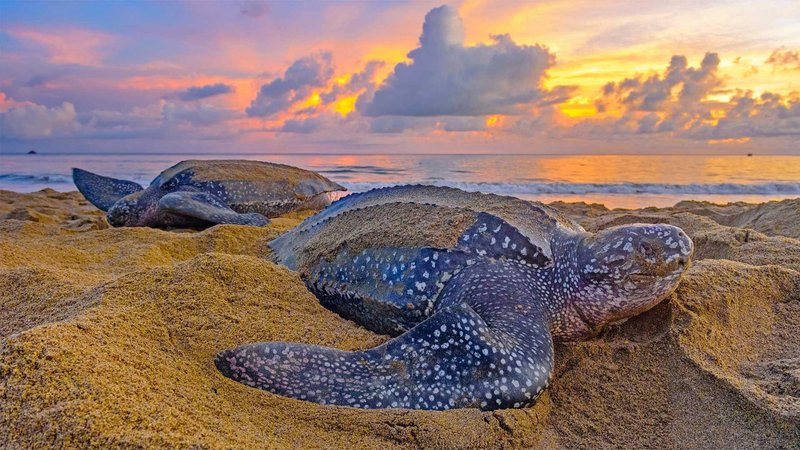
Imagine being in a giant swimming pool filled with saltwater, and stretching across it is a maze of different habitats. That’s how leatherback turtles see their environment. They don’t just stick to one spot; they glide through the waters of the Atlantic, Pacific, and Indian Oceans, often traveling thousands of miles in search of food and suitable nesting sites. Stick with me as we dive into their habitats and learn more about where these incredible sea turtles can be found.
The Vast Oceans They Call Home
Leatherback turtles are primarily ocean dwellers. You’ll find them in temperate and tropical waters across the globe. From the warm waves of the Caribbean Sea to the chilly coasts of Alaska, they cover a lot of ground. But why do they prefer the open ocean? The answer lies in their diet. Leatherbacks feast mainly on jellyfish, which thrive in the ocean’s blue depths.
Interestingly, leatherbacks are known to dive deeper than any other sea turtle, reaching depths of up to 4,000 feet! This ability allows them to hunt for jellyfish in the cooler, darker waters. Imagine a deep-sea adventure where they swim among colorful fish and other marine life, all while searching for their next meal.
In addition to their food sources, oceans also provide breeding grounds. Female leatherbacks return to the beaches where they hatched to lay their eggs, demonstrating a strong sense of homing. This return trip is crucial for the survival of their species, as the sandy beaches offer a safe place for their young to emerge.
Migration Patterns: A Journey of Thousands of Miles
One of the most astonishing aspects of leatherback turtles is their migration patterns. These turtles travel between nesting and feeding sites, covering thousands of miles each year. For example, some leatherbacks migrate from nesting beaches in the Caribbean up to the waters of the North Atlantic, showing just how far they can roam.
During this journey, leatherbacks face various challenges, including predators, changing water temperatures, and human activities like fishing and pollution. Picture them navigating through busy shipping lanes and dodging fishing nets. It’s a tough life, but their instinct to migrate keeps them thriving.
What drives these migrations? In simple terms, it’s all about food and reproduction. When they finish nesting, they seek abundant food supplies in rich feeding grounds. This constant movement is how leatherbacks adapt to environmental changes and ensure the survival of their species.
Coastal Areas: A Temporary Refuge
While leatherback turtles are mainly found in the open ocean, they also visit coastal areas. These regions serve as temporary refuges where they can rest and feed. You might spot them near coral reefs or near the mouths of rivers where nutrients mix with seawater to create rich ecosystems.
Coastal habitats are essential for young turtles, too. When hatchlings first emerge from their nests, they often head straight to these areas where they can find shelter and food. The shallower waters offer protection from larger predators, making it a vital stage in their early life.
However, coastal habitats aren’t always safe. Human activity, such as shoreline development and pollution, can impact these fragile ecosystems. It’s essential to protect these areas to ensure leatherback turtles have safe places to rest and grow.
Uncommon Habitats: Freshwater Zones
You might be surprised to learn that leatherback turtles have been spotted in freshwater habitats. Occasionally, they venture into rivers, especially when they are close to the ocean. For instance, there have been reports of leatherbacks swimming up coastal rivers in search of food or during their migration.
While it’s not their primary habitat, these freshwater excursions show how adaptable leatherback turtles can be. They’ve evolved to thrive in a variety of environments, proving their resilience and resourcefulness. However, these excursions are rare and usually tied to specific feeding opportunities.
Bear in mind that freshwater habitats come with their own challenges. Pollution and damming can disrupt their journeys and affect their health. Protecting these freshwater zones is vital, even if leatherbacks don’t spend a lot of time there.
Conservation Efforts: Protecting Their Homes
As we’ve seen, leatherback turtles face many threats in their habitats, from illegal fishing to habitat destruction. Conservation efforts are crucial to ensuring their survival. Organizations around the world are working to protect nesting beaches and promote sustainable fishing practices.
Many countries have designated protected areas along their coasts, where turtles can nest without disturbance. Additionally, educational campaigns aim to raise awareness about the importance of protecting these majestic creatures. Protecting leatherbacks isn’t just about saving a species; it’s about maintaining ocean health and biodiversity.
You might be wondering how you can help. Getting involved in local conservation efforts, reducing plastic use, and spreading the word about the importance of turtles can make a difference. Every little bit helps!
Leatherback turtles are remarkable creatures that inhabit a variety of environments, from the depths of the ocean to occasionally venturing into freshwater. Their migratory nature and adaptability make them a vital part of our marine ecosystems. It’s fascinating to think about the lengths they go to—literally and figuratively—to find food, nest, and survive.
By understanding where leatherback turtles are found and the challenges they face, we can better appreciate the role we play in their conservation. Protecting their habitats is essential not just for their survival but for the health of our oceans as a whole. So next time you think about these incredible creatures, remember that their journey is worth protecting. Let’s do our part to ensure they continue to thrive for generations to come.

